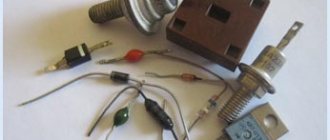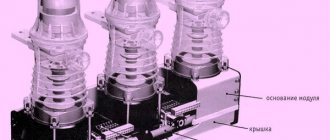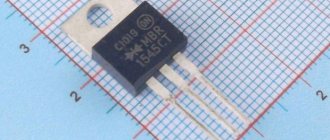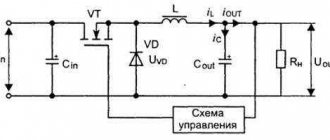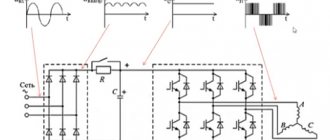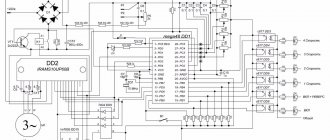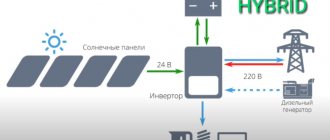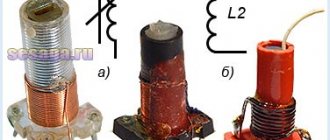06/30/201606/30/2016 master
By collecting various electrical devices in their home laboratory, many people not only save money on purchasing new equipment, but also repair broken electrical products. For full operation of many devices, diodes are required, which today come in a wide variety of varieties. In today's article we will talk about an element that is quite often found in electrical circuits - a vacuum diode.
To use such a part correctly, you need to know its structure, as well as what circuit and operating principle are characteristic of it. You will learn about all this from this article.
What is the device
A modern vacuum-type diode is a cylinder made of metal-ceramic or glass , devoid of air. Air is pumped out of this balloon to a pressure of 10-6 - 10-7 mmHg. Art. Hence the name of this element of electrical circuits.
Structure of a vacuum type diode
Inside such a cylinder there are two electrodes. One of them is the cathode. It has the form of a metal vertical cylinder, which is coated with a layer of alkaline earth metal oxide (calcium, strontium, barium). Thanks to this deposition, this element is called an oxide cathode.
Note! When it is heated, significantly greater emission of electrodes occurs from the surface than from a conventional metal element of a similar type.
The cathode inside contains an insulated conductor heated by alternating or direct current. When heated, the cathode emits electrons, which move and reach the second element of the vacuum diode - the anode. The anode has the form of an oval or round cylinder. It has a common axis with the cathode. The circuit of a vacuum type diode is as follows.
Vacuum type diode circuit
In addition to the vacuum diode, there is also such a thing as an electric vacuum diode. A vacuum diode refers to a two-electrode vacuum tube. Its structure is similar to a vacuum type diode. Essentially it's the same thing. Here the cathode is a W-shaped or straight filament. During the operation of such a lamp, it heats up to a certain temperature. As a result of heating, thermionic emission occurs. When a negative voltage is applied to the anode relative to the cathode, electrons are returned back to the cathode. When a positive voltage is applied to the anode, some of the emitted electrons begin to move into it. The result is a current. As a result of their work, vacuum diodes and their analogues are capable of rectifying the voltage applied to them. Vacuum rectifiers have this basic property, which is why they are used as detectors of high-frequency signals and alternating current rectification. This device is typical for all products of this type. At the same time, this device determines the main characteristics of the product, as well as what application it will have.
Note! The frequency range for a vacuum type diode is somewhat limited and does not exceed 500 MHz. At the same time, disk diodes integrated into the waveguides are capable of detecting frequencies up to 10 GHz.
Application of diodes
One should not think that diodes are used only as rectifiers and detectors. In addition, you can highlight many more of their professions. The current-voltage characteristics of diodes allow their use where nonlinear processing of analog signals is required. These are frequency converters, logarithmic amplifiers, detectors and other devices. Diodes in such devices are used either directly as a converter or form the characteristics of the device when included in the feedback circuit. Diodes are widely used in stabilized power supplies, as reference voltage sources (zener diodes), or as switching elements of storage inductors (pulse voltage stabilizers).
Rectifier diodes.
Using diodes it is very easy to create signal limiters: two diodes connected back-to-back - in parallel serve as excellent protection for the input of an amplifier, for example, a microphone, from supplying an increased signal level. In addition to the listed devices, diodes are very often used in signal switches, as well as in logic devices. It is enough to recall the logical operations AND, OR and their combinations. One type of diode is LED. Once upon a time they were used only as indicators in various devices. Now they are everywhere, from the simplest flashlights to TVs with LED backlighting, it is simply impossible not to notice them.
It will be interesting What is a dinistor?
Diode parameters
Diodes have a lot of parameters and they are determined by the function they perform in a particular device. For example, in diodes that generate microwave oscillations, a very important parameter is the operating frequency, as well as the cutoff frequency at which the generation fails. But for rectifier diodes this parameter is completely unimportant. The main parameters of rectifier diodes are shown in the table below.
Table of main parameters of rectifier diodes.
In switching and switching diodes, the switching speed and recovery time, that is, the speed of full opening and full closing, are important. In high-power power diodes, power dissipation is important. To do this, they are mounted on special radiators. But diodes operating in low-current devices do not need any radiators. But there are parameters that are considered important for all types of diodes, we list them:
- U pr. – permissible voltage on the diode when current flows through it in the forward direction. You should not exceed this voltage, as this will lead to its damage.
- U rev. – permissible voltage on the diode in the closed state. It is also called breakdown voltage. In the closed state, when no current flows through the pn junction, a reverse voltage is formed at the terminals. If it exceeds the permissible value, this will lead to a physical “breakdown” of the pn junction. As a result, the diode will turn into an ordinary conductor (burn out).
Schottky diodes are very sensitive to excess reverse voltage, which very often fail for this reason.
Conventional diodes, for example, silicon rectifiers, are more resistant to excess reverse voltage. When it is slightly exceeded, they go into a reversible breakdown mode. If the diode crystal does not have time to overheat due to excessive heat generation, then the product can work for a long time.
- I ave. – direct current of the diode. This is a very important parameter that should be taken into account when replacing diodes with analogues or when designing homemade devices. The magnitude of the forward current for different modifications can reach tens and hundreds of amperes. Particularly powerful diodes are installed on the radiator to remove heat, which is formed due to the thermal effect of the current. The PN junction in direct connection also has low resistance. At small operating currents its effect is not noticeable, but at currents of a few to tens of amperes the diode crystal heats up noticeably. For example, a rectifier diode bridge in an inverter welding machine must be installed on a radiator.
- I return – reverse current of the diode. The reverse current is the so-called minority carrier current. It is formed when the diode is closed. The amount of reverse current is very small and in the vast majority of cases it is not taken into account.
- U stabilization – stabilization voltage (for zener diodes). Read more about this parameter in the article about zener diode.
It will be interesting What is an LED
In addition, it should be borne in mind that all these parameters in the technical literature are printed with the “max” symbol. The maximum permissible value of this parameter is indicated here. Therefore, when choosing the type of diode for your design, you must count on the maximum permissible values.
High current diodes.
Shapes of the main diode elements
Cathode and anode shape
The cathode included in a vacuum-type diode often has the shape of the Latin letters W or V. This shape is used to increase the length of the product. At the same time, the anode will be more profitable if it is manufactured in the form of a box without side edges. In cross-section, the anode has the shape of a rectangle with rounded corners.
This shape of the anode is determined by the need for it to be at the same distance from the heated cathode in all directions as possible. For this reason, the most advantageous shape for both elements is elliptical. To reduce the degree of heating of the anode, ribs (wings) are often included in its design. Thanks to their presence, the anode has better heat dissipation. Both the cathode and anode in the cylinder are secured using special holders. For greater ease of use, a base consisting of insulating material is installed at the bottom of the lamp. It is equipped with metal pin legs. These pins provide contact for the lamp when it is plugged into the lamp panel sockets. Such a device has an electric vacuum lamp or a vacuum-type diode.
Comparison with semiconductor diodes [ | ]
Compared to semiconductor diodes, vacuum diodes have no reverse current and can withstand higher voltages. Resistant to ionizing radiation. However, they are much larger and less efficient.
- Kleiner E. Yu. Fundamentals of the theory of electron tubes. - M., 1974.
- Electronic devices: Textbook for universities/V. N. Dulin, N. A. Avaev, V. P. Demin and others; Ed. G. G. Shishkina. - M.: Energoatomizdat, 1989. - 496 p.
- Physical encyclopedic dictionary. Volume 5, M. 1966, “Soviet Encyclopedia”
Without footnotes, it is difficult to determine which source each individual statement comes from. You can improve the article by providing footnotes to sources that support the information. Information without footnotes may be deleted.
Vacuum diode Wikipedia
The interdependence of current and voltage at the anode appears in accordance with the power law of 3/2, where one of the variables depends on the increase in cathode temperature.
Expert opinion
It-Technology, Electrical power and electronics specialist
Ask questions to the “Specialist for modernization of energy generation systems”
The principle of operation of the diode. Volt-ampere characteristics. Breakdowns of pn transition | For the home, for the family The interdependence of current and voltage at the anode appears in accordance with the law of the power of 3 2, where one of the variables depends on the increase in cathode temperature. Ask, I'm in touch!
Operating principle of a vacuum type diode
In order for the circuit, which includes a vacuum-type rectifier, to work as it should, you must understand the operating principle of such a part.
Diode operating principle
The operating principle of vacuum diodes is as follows:
- as the cathode heats up, electrons from its surface will begin to separate;
- their separation occurs due to the formation of thermionic emission;
- electrons released from the surface begin to prevent the emission of other electrons. As a result, a cloud of electrons forms around the cathode surface;
- some of the electrons of this cloud, which have the lowest velocities, fall back to the cathode surface;
- in a situation where a certain temperature is set, the electron cloud stabilizes. This means that the same number of electrons fly out from the cathode as are then dropped onto it;
- in the presence of zero voltage, for example, in a situation where the anode is short-circuited to the cathode, an electron current begins to flow in the lamp in the direction from the cathode to the anode. In this situation, the fastest electrons are able to overcome the existing potential well, which is why they are attracted to the anode. Current cutoff occurs in a situation when a negative blocking voltage is applied to the anode. This voltage should be one volt or lower.
- in the situation of applying a positive voltage to the anode, an accelerating field is formed in the diode, which contributes to an increase in the current at the anode. When the current on this element reaches values that are close to the cathode emission limit, the current growth slows down and stabilizes. Those. a “saturation” effect is observed.
This is the principle that vacuum-type diodes operate on.
Significant characteristics of protection diodes
The voltage value at which the diode opens and the potential is transferred to the common wire. An additional synonymous designation is VBR.
Iobr.
Maximum reverse leakage current. It has a small value, measured in microamps, and the functionality of the device practically does not depend on it. Additional designation - IR.
Urev.
The value is an indicator of constant reverse voltage. V.R.W.M.
U limit imp.
The highest value for limiting impulse voltage. VCL, VCmax.
Ilim.max.
The highest value of the peak pulse current. Otherwise, this is an indicator of the greatest strength of the current pulse that is safe for the protective diode. For the most effective limiting zener diodes, this value can be hundreds of amperes. IPP.
Rimp.
Indicator of the highest value of permissible pulse power. Unfortunately, this parameter is extremely dependent on the pulse duration.
Fig. 2 VA characteristics of the protective diode
The power level of protection diodes is not the same. However, if the suppressor does not have enough initial data on this parameter, it can easily be combined with one or more semiconductors, which will have a positive effect on the overall power level.
A TVS diode can act as a zener diode. But first you need to check its maximum power dissipation and dynamic current at Imax. and Imin.
An important characteristic of a diode element is the current-voltage characteristic
All diodes, regardless of whether they are vacuum or not, have such a parameter as a current-voltage characteristic, or abbreviated as I-V characteristic.
I-V characteristic of a vacuum diode
To understand what kind of volt-ampere characteristic this is, let’s look at the graph using the example of the processes occurring in the lamp. At the very beginning, when there is no voltage at the anode, an electron cloud forms around the cathode as a result of its heating. When a small positive voltage appears at the anode, the fastest electrons entering the cathode electron cloud begin to rush towards the anode. As a result, it is possible to record a small anode current. In a situation where the anode voltage continues to increase, an increasing number of electrons from the electron cloud will flow to the anode into the flesh until the cathode electron cloud is completely “absorbed.” This state corresponds to point B in the graph above. This voltage means that all electrons escaping from the cathode will be immediately attracted to the anode. Note! There is no further increase in the anode current while maintaining the incandescent value. To achieve an increase in this indicator, it is necessary to use additional electrons. But they are not here. To increase this indicator, the cathode heat can be increased, but this method is not used because it leads to a decrease in the service life of the cathode element. Thus, all cathode emission at a specific filament temperature will be exhausted. As a result, the anode reached a “current saturation” situation. All these processes, step by step, are based on the volt-ampere characteristics given above. A parameter such as the current-voltage characteristic at the highest point can be considered as the limit of the diode's capabilities. As you can see, the operating principle of the product is inseparable from the current-voltage characteristic. Moreover, the latter is his reflection.
Vacuum diode: device, principle of operation, current-voltage characteristics > Light and lamps
- The cathode heats up and the separation of negatively charged particles begins.
- The process of thermionic emission is developing.
- Already free particles block the separation of other particles, and an electron cloud is formed.
- The electrons with the slowest moving speed are attracted back to the cathode.
- At a strictly fixed temperature, the electron cloud stabilizes. That is, the number of electrons flying off coincides with the number of electrons settling
Where are these products used?
The use of vacuum tubes is determined by their basic capabilities or properties, namely the ability to pass current in only one direction. This is due to the fact that in a diode the movement of electrons is only possible from the cathode to the anode. Sometimes this property of diode rectifiers is called one-way conductivity. Due to this property, vacuum diodes are used as a DC-AC converter (its rectification). Such capabilities of this type of product have ensured their extensive use in radio equipment.
Note! The use of a vacuum-type diode will solve the problem of powering radio equipment from an industrial AC network.
The circuit by which you can use a diode as a rectifier for alternating current is quite simple.
Diagram of a diode operating as a rectifier
In this situation, an AC source should be connected between the anode and cathode. The top of the graph shows the AC source voltage. Here there is a periodic change with a certain frequency like a sinusoid. The voltage at the anode changes with the same purity in relation to the cathode. Part of the time the anode will be positive (top of the graph), and part of the time it will be negative (bottom of the graph). With positive half-cycles, there will be a positive voltage at the anode. In such a situation, the current will flow, but with the opposite value of the half-cycle, it will be absent. The result is pulses equal in frequency to alternating current.
Main conclusions
It is possible to use the advantages of vacuum diodes in radio-electronic devices if the principle of their operation is known. Each type of these lamps has individual characteristics, so it works effectively only in certain conditions. Maximum benefit can be obtained if you take into account the current-voltage characteristics and other important parameters when choosing.
Previous
LEDsCharacteristics and applications of Cree XML T6 LEDs
Next
LEDs RGB LED strip: technology, difference from the usual one, connection
Marking of devices[ | ]
Electrovacuum diodes are marked according to the same principle as other lamps:
- The first number indicates the filament voltage, rounded to the nearest whole number.
- The second symbol indicates the type of vacuum device. For diodes:
- D
- single diode. - C
- kenotron (rectifier diode) - X
is a double diode, that is, containing two diodes in one housing with a common filament.
MX
- mechatron-double diode - MUKH
- mechatron-double diode for measuring angles - The next number is the serial number of the device's development.
- And the last symbol is the design of the device:
- C
- a glass cylinder with a diameter of more than 24 mm without a base or with an octal (eight-pin) plastic base with a key. - P
- finger lamps (glass cylinder with a diameter of 19 or 22.5 mm with rigid pin terminals without a base). - B
- miniature series with flexible leads and a case diameter of less than 10 mm. - A
- miniature series with flexible leads and a case diameter of less than 6 mm. - K
- a series of lamps in a ceramic housing.
If the fourth element is missing, then this indicates the presence of a metal case!
Device[ | ]
Designation on the diagrams of a diode with an indirectly heated cathode.
An electric vacuum diode is a vessel (balloon) in which a high vacuum is created. The cylinder contains two electrodes - a cathode and an anode. A directly heated cathode is a straight or W-shaped filament heated by a filament current. An indirectly heated cathode is a long cylinder or box, inside of which an electrically insulated heater coil is laid. Typically, the cathode is embedded inside a cylindrical or box-shaped anode, which in power diodes may have fins or “wings” to dissipate heat. The terminals of the cathode, anode and heater (in indirect incandescent lamps) are connected to external terminals (lamp legs).
